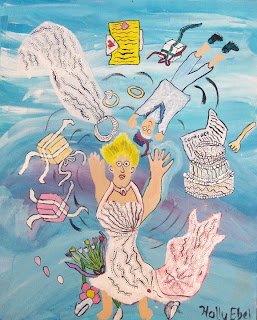Lars and the Real Girl was released in 2007 to not a lot of acclaim, except a smidgen for Ryan Gosling's incredibly moving performance. I've seen it three times now, and each time
Lars moves me more as I see how the writer Nancy Oliver creates a universe that's Utopian in scope, but utilitarian in the way it is conveyed. The premise sounds like a stupid joke, which is probably why the movie did not get as much notice as it should have. Lars is a functional recluse who lives in the garage behind the house where he grew up. His brother and sister-in-law live in the house-proper. The sister-in-law, Karen, is trying desperately to include Lars in their domesticity, even at one time tackling him out in the snow to ensure he makes it to dinner. As played by Emily Mortimer, Karen is the beating, beautiful heart of the movie: someone so guileless and sweet that she feels the need to enforce kindness, not just give it.
And that's the way many of the townspeople in
Lars and the Real Girl come across throughout the rest of the film. When Lars orders a fake girl through the Internet (and it's a salacious website he gets it from, advertising poor lost lonely orphan-girls to be adopted by poor lost lonely old men), and the girl arrives, you expect the movie to lurch into simpleminded, mean-spirited comedy. Even the third time when I watched I was almost anticipating some crude aside I missed the first two times, but the triumph of the film is that it takes that low-grade concept (lonely loser purchases a fake doll to make love to) and elevates it by paying attention to what the fake girl means, and how her presence in Lars' life allows him to find his way out of all the traps he has set for himself.
This time seeing it I noticed even more of the disability aspects of the movie. In order to move Bianca (the fake girl) around Lars imagines a disability for her, so he has to get a wheelchair for her. Bianca, his first love, is a woman with a disability, and yet the townspeople, when asked to help Lars through his delusion by believing in it along with him by the local family doctor (a miraculously understated Patricia Clarkson), take Bianca into their midst as one of their own. They provide her with a job at the mall as a model, and eventually she is even voted onto the schoolboard. In her vacantness and in her pliability, Bianca becomes a perfect symbol for human kindness.
And Lars is as well a person with a disability: loneliness manifesting itself into a delusion, some kind of mental illness, I'm sure, but what the movie does is dramatize not the internal aspects of "being disabled," but the external ones movies always miss. When Lars goes to a party with Bianca, there are stares and comments, but there's also this feeling that somehow Lars is using Bianca to let people know how human he is too, and how much he needs. He could never tell them that upfront, so Bianca becomes his visual cue, and we see him and what is "wrong with him" through innocent eyes. His attention to Bianca, his devotion to her, becomes as natural and real as any romance in movies can be.
"Disability" gets deconstructed because the secrecy and shame usually connected to a story like Lars' are not there. He is openly courting a fake girl he ordered over the Internet, and guess what? Everyone in town is in on it. The "disabilities" inherent in both Bianca and Lars' bodies and persona are somehow "owned" by everyone, and in the end a sort of catharsis happens, at least for me, as I watched. Throughout the film, Ryan Gosling's face transforms from the face of a weary, half-dead soldier in the beginning to a beautiful half-asleep silent-movie comedian in the end. He finds peace, a casual insouciance, but there's neediness still in his eyes, and a desire coming from his forehead somehow to figure out how to be who he is, and get what he wants out of life, without losing his mind. Lars' quest becomes a sane journey if not to self-acceptance, at least to accepting reality, which is probably the same thing. And this movie truly does something miraculous: it delivers a tableau hardly ever constructed for movies and rarely seen in true life: people being nice to each other, even when being nice means putting up with something they might easily toss aside as "deranged" or "sick."
It's a lovely thing to behold.























